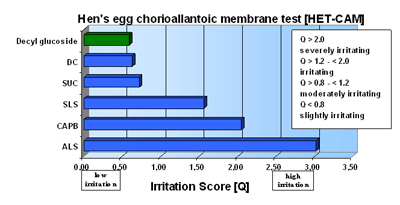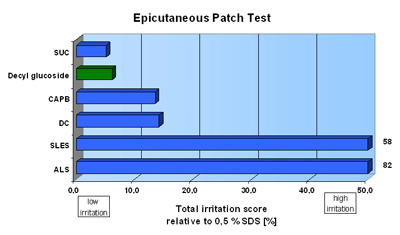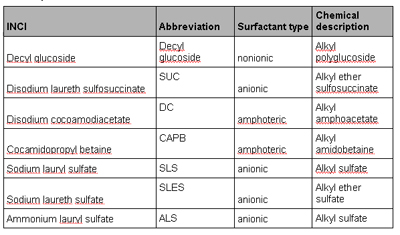APG: A Green Success Story
I did a lot of product formula testing with Cognis products. One of the things I really liked about using their core ingredients was their dedication to green and sustainable development. As well, their quality was outstanding, their supply chain was fast and dedicated, and their scientists were always available to answer questions and help tweak formulas.
All that said as an introduction to a recent whitepaper: Alkyl polyglucosides represent a solution for manufacturers to combine efficiency with ecological congeniality and human safety in the final product.
The green movement continues to grow as more consumers are becoming aware of the impact that the products they use have on themselves, society and the environment. This new green consciousness is making consumers change their consumption habits and thus their purchasing criteria. In concrete terms, consumers are increasingly interested in products that contain natural ingredients and respect the environment.
According to Organic Monitor, sales of natural personal care products worldwide reached approximately $7.3 billion in 2007. In the home care sector, a 2004 study by Green Marketing Inc., revealed that 69% of respondents preferred natural detergents to those derived from synthetic ingredients because they are commonly considered to be safer, especially where children are concerned. Along with environmental sensitivity, consumers expect products to be effective and high-quality. These expectations are forcing manufacturers to review their product lines and to develop innovative, environmental-friendly solutions that are both efficient and cost-effective. One example of a key ingredient being used to develop new products which satisfy the consumers “green” consciousness are alkyl polyglucosides. Alkyl polyglucosides can be used in personal and home care applications as well as in those for the I&I sector.
A Green Surfactant Emerges
Alkyl polyglucosides are nonionic surfactants with origins in the 19th century. For a long time, they were only of academic interest. In 1893, the German chemist Emil Fischer synthesized alkyl polyglucosides by combining fatty alcohols and glucose obtained from coconut or palm kernel oil and corn. However, it took almost 100 years to progress from simple laboratory experiments to the industrial production of alkyl polyglucoside surfactants and their use in formulations.
In 1989, Cognis, at the time still part of the Henkel Group, succeeded in designing an industrial production process for alkyl polyglucoside surfactants.1 They were originally developed for the home care and body wash segments. Nowadays the applications for alkyl polyglucoside surfactants are as diverse as the products on the shelves of retailers, drugstores, and beauty shops: From baby foam-bath products to facial cleansing lotions, shampoos, and oral care products, from wipes to laundry detergents, hard surface cleaners, and I&I cleaning applications.
Alkyl polyglucoside surfactants are obtained from renewable, plant-derived raw materials and therefore are suitable for products where mildness to human skin, environmental compatibility and high performance are a must. Alkyl polyglucosides have been extensively tested in various eco-toxicological studies.2 No environmentally harmful intermediates are formed even during mineralization to carbon dioxide and water; nor do the surfactants release any undesirable by-products such as nitrogen, ethylene oxide, or preservatives. For all these reasons, many formulators see alkyl polyglucosides as the ideal “green” surfactants which add value to their products and help them to distinguish these products from conventional ones.
“Greenness” Meets Mildness
Companies such as Yves Rocher, a cosmetic producer of botanical beauty care products, have been using alkyl polyglucosides since the beginning of the 1990s. Questioned about their preference for APG, Stéphanie Collet, Lab Manager for the Toiletteries Lab at Yves Rocher stated: “We regard alkyl polyglucosides as mild, “green” and biodegradable surfactants which offer a benefit for consumers in terms of very mild formulations combined with an extraordinary environmental profile.”
Dirk Develter, R&D Manager of Ecover, an international company active in the production of ecological cleaners and detergents, confirms: “In comparison to other surfactants, alkyl polyglucosides are very much in line with our concept of sustainability, including interesting features such as full renewability, low aquatic toxicity and full biodegradability without stable metabolites.”
In fact, within the framework of international regulations concerning eco-friendly products, alkyl polyglucosides meet the requirements for highly accepted green labels such as Ecocert, the EU Eco-Flower, Green Seal and many others.
In addition to their ecological footprint, alkyl polyglucosides are not toxic or harmful to human health and show a lower skin irritation than other surfactants. It is essential that the surfactants used in personal and home care products have minimal irritation potential because it is inevitable that these products come into contact with the skin. A comparative study.3 of various surfactants showed that alkyl polyglucosides possess superior mildness compared to other surfactants found in the market, confirming the well-known association of “greenness” with mildness.
Two of those tests, the red blood cell test (RBC; Pape et al., 1999; INVITTOX Porotcol Nr. 37) in Figure 1 and the epicutaneous patch testing (ECT; 24 hour occlusive patch test) Figure 2, assess the mucous membrane/ocular irritation potential of different surfactants and the primary skin irritation in humans respectively.
Fig. 1: Figure 1: Ocular/mucous membrane Irritation potential: Results of a HET-CAM Test (3% AS; pH 6.5) |
As surfactants at higher concentrations or with an extreme pH make irritation more possible, the surfactants were tested at the same pH and at the same active substance content. To make sure that microbial contamination does not occur in the absence of preservatives, the pH of alkyl polyglucosides is adjusted to approximately 12.
Fig 2: Results a 24 hour occlusive epicutaneous human patch test (2% AS; pH 6.5; n=21) |
However, home and personal care products should not only be mild but also have a high cleansing efficacy. Alkyl polyglucosides can satisfy these requirements based on their exceptional skin compatibility and deep pore cleansing properties for personal care products as well as exceptional cleaning performance in home care and I&I products without leaving residues on the cleaned surfaces. One property that goes hand in hand with the cleansing process is the formation of foam. Consumers perceive the formation of foam as an inherent part of the cleaning phase in personal care products such as shampoos and shower gels as well as in home care products such as laundry detergents and manual dishwashing liquids. Alkyl polyglucosides, alone or in combination with other surfactants, produce foam with a good balance between volume and stability in all the above-mentioned applications.
Table 1: Description of the surfactants tested in this study |
Additional benefits that formulators regard as positive in alkyl polyglucosides include the absence of ethoxylates or sulfates in their composition and their stability over a wide pH spectrum as described by Stéphanie Collet from Yves Rocher: “Alkylpolyglucosides allow the possibility to formulate transparent products through a broad range of pH values”.
Dirk Develter (Ecover) also stated: “Alkyl polyglucosides are stable over a wide pH range, which makes them suitable for use in highly alkaline I&I cleaners as well as in acid cleaners without the anaerobic degradation issues of sulfonated surfactants.”
Conclusions
In the light of the green movement, consumers will continue to favor products with natural and environmentally sound ingredients. As a consequence, the demand for green surfactants will continue to escalate in terms of raw materials. Alkyl polyglucosides are nonionic surfactants obtained from renewable, plant-derived raw materials which enable the formulation of modern personal and home care as well as I&I products. Their ideal environmental and skin compatibility as well as high performance profiles meet consumers’ demands within the green trend perfectly. Manufacturers following the green movement acknowledge the benefits that alkyl polyglucosides have brought to their formulations, supporting them until today to clearly differentiate their products from others. Innovative companies actively offering green solutions, such as Yves Rocher in the personal care market and Ecover in the home care and I&I segment, confirm that alkyl polyglucosides are a must when aiming for the best performance, especially in green products.
References
1. Hill, K., von Rybinski W., Stoll G. (1997) Alkyl polyglycosides: Technology, properties and application. Ed. VCH, Germany. pp 1-7;71-130.
2. Willing A., Messinger H., Aulmann W. (2004) “Ecology and Toxicology of Alkyl polyglucosides”. In: Handbook of Detergents. Ed. U.Zoller, Marcel Dekker, New York, pp. 487-521.
3. Mehling A., Kleber M., Hensen H. (2007) Comparative studies on the ocular and dermal irritation potential of surfactants. Food Chem. Toxicol. 45, 747-58